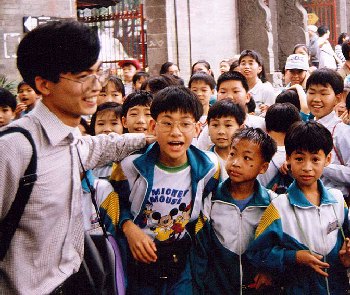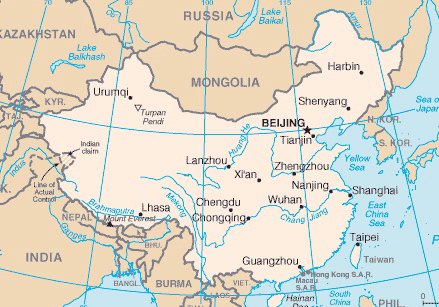|
|
|||||||||||||||||||||||||||||||
|
Privatizing Education in China
The Impact of Neo-liberalism on China's Education System
China has gone through 30 years of reformation, and it’s more and more like a capitalism country but not what they claim as a socialism country. During this transition time, there are lots of social problems arising and social justice in China is undoubtedly affected. By analyzing China’s situation we can track neo-liberalism’s growth. By Samuel Mao - 2008. Guangzhou Yucai Middle School and Guangzhou Yucai Experimental School, in Guangzhou China are both run by the same public school administration, but one is a public school and one is a private school. I went to Guangzhou Yucai Middle School for my secondary education, and I witnessed the formation of the connection between these two schools. Guangzhou Yucai Middle School is a public school with more than fifty years history and it’s ranked in the first class of the public school system in the city. Guangzhou, where the school is located, is the third biggest city in China, right after Beijing and Shanghai. It was this reputation that led a developer to approach Guangzhou Middle Scholl about the possibility of establishing a private school in their housing development. In recent years, China’s real estate market has been booming. More and more luxurious living areas are being built in big cities. By law, developers have to include schools, parks, and other public facilities in their projects. Developers focus on locating schools with a first class reputation in their developments to attract buyers. With this goal in mind, a real estate developer contacted Guangzhou Yucai Middle School, a public school, and made a deal. The deal was that the developer provides land and some money to the school and the school provides educational support for establishing a school in his development with the brand of Yucai. Therefore, the Yucai Middle and Experimental schools are under the same public school’s management and have similar education quality, but Yucai Middle is a public school, Yucai Experimental is a private school.
The roots of this kind of private public partnership dates from the late 1970s, after the death of Mao Tse Tung, when Deng Xiao Ping became the Chinese leader and started to reform the economy to bring market reforms to the socialist society. These changes go by the name “socialism with Chinese characteristics”. The goal was to make the economy function with market principles under the guidance of the neo-liberal economist Milton Friedman. With thirty years of economic reform and social changes, China has been deeply impacted by neo-liberalism. Although these reforms have led to an increase in the overall enrolment in elementary and secondary schools, they have also led to growing inequality in access to education across the country. As early as 1985, China started to reform its education system. The policy thrust was toward decentralization and privatization. The central government reduced its own control, and now only plays “the role of ‘macro-management through legislation, allocation of funding, planning, information service, policy guidance and essential administration’” (Mok and Lo, 2007). At the same time, the central government recognized the importance of providing basic education. Therefore, they continued to provide enough funding for elementary and junior and senior secondary schools to achieve the policy goal of compulsory education for all. Because of this, enrolment increased. According to Ministry of Education statistics, in the year of 2002 the net enrollment ratio of primary schools in China was 98.58%; the gross enrollment ratio of junior secondary schools had 90%, and the gross enrollment ratio of senior secondary schools which is not a part of compulsory education also reached 81.2%. In 1992, these three ratios had been 97.2%, 71.8%, and 48.6%. The central government’s policy of providing adequate funding and consolidating basic education have been successful in increasing enrolment, but negative impacts do exist. As mentioned, the focus of the reform is about decentralization, which gives local governments, schools, and education departments more operational autonomy and financial flexibility, which may have contributed many of the corruption cases that have come to light in recent years. Local schools and education departments, for example, often charge excessive fees, like “school selection fees”, from students. There are no education vouchers in China, and students technically can only attend their local school for compulsory education, and their testing scores have to meet the admission requirements for secondary education. “School selection fees” function as “education vouchers” in this situation. Students can pay fees to enter a more desirable school even if it is outside of their area or they can’t meet the admission requirement. The result is inequality in China’s basic education system. The school selection fees are gradually making schools like Yucai Middle School into schools for rich people or at least middle income people. As low income students are being squeezed out of public schools like Yucai Middle School, the growing number of private schools like Yucai Experimental School provides even more options for the wealthy. Wealthy students who do not have the standardized test scores and who cannot get access to first class public schools through school selection fees have the option of paying for first class private schools. Both “school selection fees” and the private sector in public school system create education inequality, and this inequality is based entirely on students’ socioeconomic status. Personally, I can see one other positive in China’s economic reform of the education system. Decentralization does give more power and space to local school boards to design curriculum based on the local culture and the local situation. However, as a country in the midst of a huge reform, China has to pay attention to the negative impacts of its policy changes. As many people have pointed out, the problem of the widening gap between rich and poor has been one of the biggest challenges in China's reformation. The challenge of this disparity is easily found in China’s education system. In general privatization is creating inequality in China's education system.
ReferencesMok, Ka Ho and Lo, Yat Wai (2007). The Impacts of Neo-liberalism on China’s Higher Eduaion , The journal for Critical Education Policy Studies, Volume 5, November 1: May 2007, Centre for East Asian Studies, University of Bristol. Kwong, Peter (2006). The Chinese Face of Neo-liberalism, 7th October, 2006. Li, Li (2007). Healthcare Under Fire, BeijingReview.com: No.10, 8th March 2007. The National Bureau of Statistics of People’s Republic of China (2007). Consumer Price Index (CPI) kept growth in October. The Ministry of Education of People’s Republic of China (2003). Report of Education Statistics Volumn 1 No. 26, 27th February, 2003. Klein, Naomi (2007). The Shock Doctrine: The rise of disaster capitalism, Alfred A. Knope: Canada. Friedman, Milton (2002). Capitalism and Freedom, ed. 2002. The University of Chicago Press, Chicago.
|
|
||||||||||||||||||||||||||||||
|
Website Design + SEO by designSEO.ca ~ Owned + Edited by Suzanne MacNevin | |||||||||||||||||||||||||||||||


